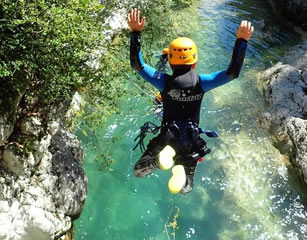 Canyoning or canyoning is an outdoor activity related to caving, and white water sports. We travel through waterfalls, parades, gorges, valleys, rivers, streams by walking, swimming, climbing or abseiling.
Canyoning or canyoning is an outdoor activity related to caving, and white water sports. We travel through waterfalls, parades, gorges, valleys, rivers, streams by walking, swimming, climbing or abseiling.
The discipline is French. It was at the end of the 19th century that the first canyon explorers appeared. Armand Jamet was one of the pioneers, in 1893 descending the Artuby canyon in Verdon with a simple rope and a wooden plank. (more than rudimentary equipment). These are French cavers who used their techniques of underground progression. They conceived of canyoning as “open-air caving”, “an extension of their exploration of the underground world”. France, a pioneer in the discipline, remains the best equipped European country.
Canyoning consists of progressing in the bed of rivers whose flow ranges from low (sometimes zero for “dry canyons”) to high, in portions where they run through narrow gorges or ravines, with waterfalls of various heights (max 350 m in mainland France).
We also use the English term canyoning, but the sports federations that manage this activity prefer French-sounding terms like canyoning or canyoning. In 1988 the French Federation of Speleology even spoke of open-air Speleology.
The canyons are subject to the hydraulic regimes of the mountains.
Most often, the progression follows the bed of the stream and the direction of flow of the water. It is mainly carried out on foot, but also by swimming or by using rope progression techniques commonly used in caving, in particular abseiling.
The routes that do not present any difficulties with regard to verticality are called water hikes. By strong flow, they require good control of swimming in white water. The progression in the ravines barred by many waterfalls requires mastering the maneuvers of ropes (mainly the technique of rappelling). Canyoning is therefore a specific discipline which requires good experience and various knowledge and skills to be practiced in complete safety.
Fun canyoning (generally a course with few or no high vertical passages), consisting of a succession of jumps and slides, as it appears in many reports, is only part of the activity. canyoning.
The canyons of the Verdon are mainly found in the karst system.
The Karstic or Karst system?
Karst is a geomorphological structure resulting from the hydrochemical and hydraulic erosion of carbonate rock formations, mainly limestone formations. Karst-type erosion phenomena also appear in “pseudokarst” structures. Karst structures cover about one-fifth of the Earth’s continental surface. The karsts present for the most part a tormented landscape, an essentially underground hydrographic network and a basement carved out of numerous cavities: ruiniform reliefs, losses and resurgences of rivers, caves and chasms… On the southern and western margins of the Massif Central French, the karst plateaus are called causses.
The study of karst is karstology. The study of the karst’s hydrogeological cavities and network are particularly associated with caving, underground diving and biospeology.
Let’s go back to the canyon descent.
It is a fantastic playground. Its interest lies in the variety of pleasures it provides. There are engaged canyons, others more fun, more or less vertical canyons, more or less aquatic.
Each canyon has its specificity: a different topography and food. Easy, technical, difficult or very difficult, everyone, at their level, will find something to satisfy their desires for adventure.
Some canyons require a more or less long approach walk; others can be more or less aerial; there are water canyons and dry canyons.
Fun and easy in appearance, canyoning can nevertheless become dangerous due to sudden rises in the water. It must always be practiced in good climatic condition, and with a person perfectly familiar with rope techniques but also water movement.
Water is the element that must be known, and approached without restraint, sometimes jumping a few meters in basins. You should never go against the water, you can play with it but you can’t stop it 
Canyoning is practiced with equipment adapted to the practice: full neoprene suit generally 5 millimeters, CE approved protective helmet, harness equipped with two lanyards and pants to protect the suit, closed shoes holding on to the feet with a sole preferably in flexible rubber which will adhere better to a wet surface.
To conclude, canyoning is really fun, practiced in a natural environment, where adventure is mixed with the feeling of being in danger. We are confronted with the roars of the water, the verticality, the heights to jump, the collection, the engagement at the bottom of a canyon… all this requires mastering. The progression is done in a half-terrestrial, half-aquatic way inside huge faults dug by erosion. We travel through waterfalls, parades, gorges, valleys, rivers, streams, walking, swimming, climbing or abseiling. It’s a great compilation of what a sporting summer has in store to be discovered as a matter of urgency and to be practiced with family or friends, with a qualified guide.
The Verdon region and the Alpes Maritimes offer more than a hundred canyons, all different, each more beautiful than the other, there is something for all tastes, for all levels.
For example, (clue being the Provencal term for canyon) the clue of Saint Auban in the Maritime Alps, the clue of Riolan, tributary of the Esteron, the clue of Haut Jabron. The Mainmorte ravine, the Ferné ravine, are dry and aerial canyons that flow into the grand canyon of the Verdon. Water hiking is actually level 1 canyoning, meaning that there is no rope manipulation.




